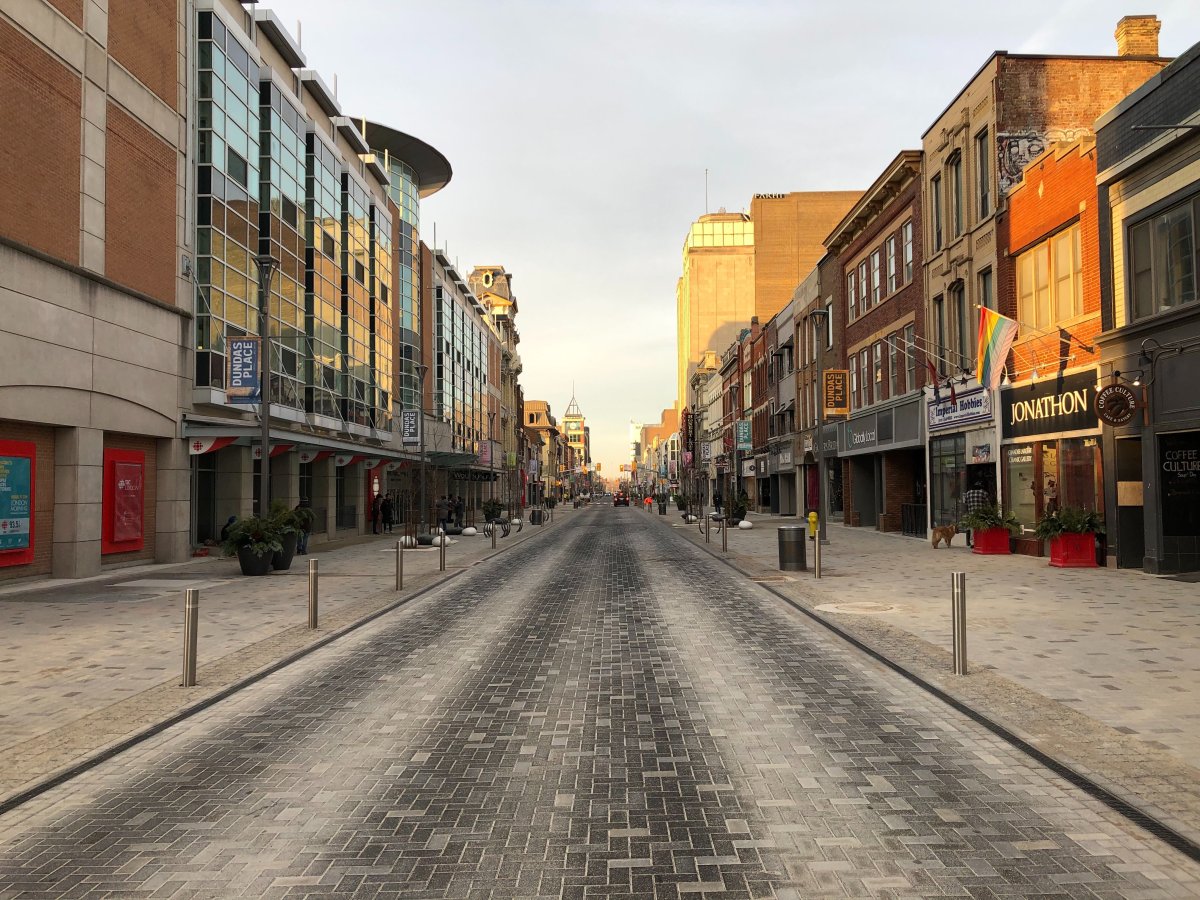City council voted on Tuesday to have traffic diversion lead upcoming temporary changes for Dundas Place, settling a debate over how the first flex street in London, Ont., will look this construction season.

The temporary changes were first pitched by city staff in late February, with the aim of mitigating traffic issues caused by nearby construction on King Street, which sits just south of Dundas Place.
City staff initially proposed turning a segment of Dundas Place into a one-way eastbound street for motor traffic, with two bike lanes heading in opposing directions sitting adjacent to a middle lane for vehicle traffic.
That idea was shot down, with concerns rising from cyclists and business owners, and city staff were sent back to the drawing board.
City staff emerged in late March with four options for the upcoming temporary changes at Dundas Place.
The temporary changes would be implemented along Dundas Place between Ridout Street North and Wellington Street.
- Option 1: Bi-directional bike lanes
- Turns Dundas Place into a one-way eastbound street for motor traffic.
- Places westbound and eastbound bike lanes on north side of Dundas Place, next to motor vehicle lane.
- Eliminates parking and loading spots on north side of Dundas Place, taking out 23 spots in total.
- Installs sporadic planter barriers.
- Cost: $175,000.
- Option 2: Uni-directional bike lanes
- Centre lane reserved for one-way eastbound motor traffic.
- Eastbound and westbound bike lanes added on either side of centre lane.
- Sporadic planter barriers where possible.
- 0.85m buffer space between vehicles and bicycles created by tactile strip.
- Cost: $30,000.
- Option 3: Traffic diversion
- Restricts vehicles to turn-only movements at Ridout Street North and Wellington Street intersections to reduce through traffic on Dundas Place.
- Cyclists placed in mixed traffic with no separate bike lanes.
- Cost: $5,000
- Option 4: Do nothing
- Cost: $0.
City councillors discussed only options 1 and 3 during Tuesday’s meeting, with the latter ultimately coming out on top.
Ward 2 Coun. Shawn Lewis opened discussions by offering support for Option 3: Traffic diversion, describing it as a “compromised solution that is not perfect for anyone, but it is something that strikes a balance that businesses, that cyclists, pedestrians and vehicles can all enjoy.”

Get daily National news
“It also means that the confusion that would be generated by switching… Dundas Place (to) one-way only traffic for this summer would be avoided,” Lewis added.
Lewis also brought forward a concern he heard from local cyclists about wanting barriers at the Dundas intersections at Ridout and Wellington streets, so that signage informing motorists of the traffic diversion wouldn’t be ignored.
City engineer Kelly Scherr said later in the meeting that city staff would provide some sort of barricade at these intersections, but would have to look into what kind of barricades would work best.
“We’ll have to make sure that right-turning vehicles off the north-south streets could still execute those turns, including larger delivery vehicles, which might minimize the ability to use some barricades,” Scherr said.
When asked how much these barricades would add to the cost of Option 3, Scherr said it would be “certainly less” than $30,000, but still more than the original $5,000 estimated price tag.
Scherr emphasized that Option 3 does not include any barriers between cyclists and motorists, as both types of traffic would occur in the same lane.
Ward 4 Coun. Jesse Helmer told councillors that while Option 1 was his preference, he would support Option 3 so long as barriers to promote traffic diversion were implemented.
“Traffic diversion by sign is not going to result in traffic diversion… we designed the street to have these barriers pop-up, to prevent people from coming into the space and I know we can do it,” Helmer said.
Deputy Mayor Josh Morgan was among a group of councillors who considered Option 3 their preference.
“I like the way that this has some flexibility to it, I like that it covers a variety of groups and I like the potential it has as a permanent solution, obviously with some further investigations,” Morgan said.
“I think it’s incumbent on us to look for a solution that provide something for both parties: for cyclists and, certainly, for the downtown business,” Ward 6 Coun. Phil Squire said.
Ward 5 Coun. Maureen Cassidy, who considered Option 1 her first preference, said traffic diversion wouldn’t provide enough protection for cyclists, as they would have to share lanes with motor traffic.
“I do feel like a separate lane for cyclists is the safest option for cyclists and it’s safest option for all levels and all ages of cyclists, which is what we should be designing our cycling infrastructure for,” Cassidy said.
Ward 9 Coun. Anna Hopkins held similar views.
“I ride a bike. I’m not an avid biker, but I do want to be able to use the streets in a safe manner,” Hopkins said.
“If not, I’m not going to bike and I’m not going to go downtown as often as I would like to.”
A vote to implement Option 1: Bi-directional bike lanes narrowly failed 7-8, receiving only support from councillors Helmer, Cassidy and Hopkins, as well as councillors Mohamed Salih (Ward 3), Stephen Turner (Ward 11), Elizabeth Peloza (Ward 12) and Ariella Kayabaga (Ward 13).
Councillors then voted 14-1 in favour of implementing Option 3: Traffic diversion, with Hopkins serving as the lone opponent.
While the initial pitch from city staff had said the upcoming temporary changes would be implemented in late April, the latest proposal did not provide a start date.
The upcoming traffic diversion is set to last for a period of seven to eight months throughout London’s construction season, which began last week.














Comments